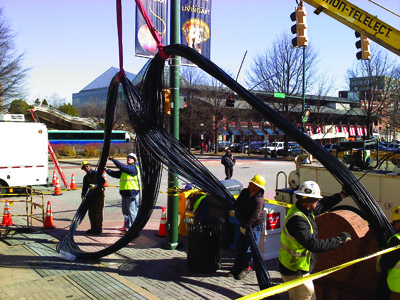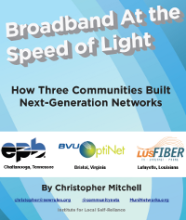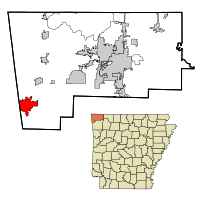Community Broadband Bits 9 - Leslie Nulty with ECFiber in Vermont


Before the economic downturn, a typical small video service provider could expect between $1.25 and $2.00 a month per subscriber in ad revenues, noted Walter P. Staniszewski, president of Prime Media Productions – a company that sells advertising for small video service provider clients. Since the downturn, the numbers are more like $1.00 to $1.50.The article focuses on the windfall cable operators are seeing due to all the money being spent by big-money interests in anticipation of the election in November. However, the smallest networks may not want to commit to ad-insertion until they are reaching thousands of homes, according to the Telecompetitor source:
“If you study the cable industry, even the big guys didn’t have their own sales force until they developed some real scale,” said Staniszewski. He cautioned operators with systems with fewer than 5,000 or 6,000 subscribers against hiring their own sales force.
Lesson 1: Google built its own network. It isn't leasing connections or services from big telecommunications companies. Building your own network gives you more control -- both of technology and pricing. Lesson 2: Google uses fiber-optics. These connections are reliable and have the highest capacity of any communications medium. The homes in Kansas City are connected via fiber whereas Time Warner Cable, CenturyLink, and others continue to rely on last-generation technologies because they are delaying investment in modern technology to boost their profits.
 Others have already followed these lessons but are not able to offer their gig for such a low prices. To understand why, let's start with some basics. I'm hypothetically starting Anytown Fiber Net in my neighborhood and I want to offer a gig.
Others have already followed these lessons but are not able to offer their gig for such a low prices. To understand why, let's start with some basics. I'm hypothetically starting Anytown Fiber Net in my neighborhood and I want to offer a gig.Recently, we let you know about the situation in Siloam Springs, Arkansas, population 15,039. The town is now investigating the possibility of building their own fiber network. They have had several community meetings and a "vote of the people" is set for May 22, 2012.
Pamela Hill is investigating the twists and turrns in a series of articles about the vote. In one of her articles, Hill looked into another Arkansas community, Paragould, home of the annual "Loose Caboose" Festival. This community, located in the northeast corner of the state, has successfully operated their own cable network since 1991. Unlike Siloam Springs, the people of Paragould weren't focused first on generating new revenue for the local government, they just wanted to be able to watch tv for a reasonable price.
Back in 1986, Cablevision was the only provider in Paragould. Hill spoke with Rhonda Davis, CFO of Paragould Light, Water & Cable:
"The public wasn’t happy with Cablevision’s service or rates,” Davis said. “We took it to a public vote and did it.”
Prior to Paragould's decision to build their own network, the City had a nonexclusive franchise agreement with Cablevision. The town was dissatisfied by the service they received and, in 1986, Paragould voters approved an ordinance authorizing the Paragould Light and Water to construct and operate a municipal cable system. Three years later, there was a referendum that authorized the city to issue a little over $3 million in municipal bonds to finance the system.
That same month, Cablevision filed suit alleging antitrust violations, breach of contract, and infringement of first and fourteenth amendment rights. The district court dismissed the antitrust and constitutional claims and Cablevision appealed unsuccessfully. The case attracted attention from lawyers and business scholars across the country.

David Cameron, city administrator, said the proposal is not so much about dissatisfaction with current providers as it is about finding new revenue for the city. Cameron said revenue from electric services has been a key source of funding for various projects and necessities for the city. That “enterprise” fund is getting smaller, Cameron said, and an alternative funding source is needed. “We have done a good job managing accounts, building a reserve,” Cameron said. “We want to keep building on the programs we have. It takes money and funds to do that.” City officials discussed the issue for the last 18 months and decided to put it to a referendum. Voters will decide the issue May 22.That is a fairly unique reason. Most communities want to build these networks to encourage economic development and other indirect benefits to the community. Given the challenge of building and operating networks, few set a primary goal of boosting city revenue.

If approved by voters, the city plans to spend $8.3 million to install 100 miles of fiber optic cable directly to homes and businesses. The city should be able to repay the debt in 12 years, if things go according to a feasibility study presented to the city’s board of directors in January.
At the current rate, EPB can shave seven years off the time it will take to pay off its telecom debt, becoming virtually debt-free by 2020 instead of 2027 as projected, Eaves [EPB CFO] said. Even so, the government utility still is spending money to sign up new customers, a process that will increase debt until 2013, Eaves said. The utility has $51 million in total debt so far, but it only needs 30,000 customers to break even on operational costs, Eaves said. "We are currently cash- flow positive from an operations standpoint, but still increasing debt to fund the capital associated with signing up new customers," he said.As we frequently remind our readers, finances are complicated. Even though the network continues to do very well, its debt will increase for a few more years while it continues rapidly acquiring new subscribers. Each subscriber takes years to pay off the debt of connecting them. Recall that EPB unexpectedly got a Department of Energy stimulus grant to deploy its smart grid much more rapidly than planned for. As the electric division owns much of the fiber fabric, the grant does not impact the finances of the Fiber-Optic division, aside from allowing EPB to roll the network out to more people more rapidly. The changed plan increased their costs and their revenues over the original plan.
Soeffker, who farms with her husband in rural Sibley County, said the dish receiver they must use works fine in good weather but balks during heavy rain and snowstorms. Meantime, her husband struggles with a lagging Internet speed of .6 megabits a second that falls short of meeting his business needs when he’s selling commodities.The committee organizing the network set a goal for demonstrating the interest of something like 50% of the population in the target area. There has been some confusion as to exactly how many they should have before committing to the project but with just two mass mailings, they have received nearly 3,000 positive responses (of the over 8000 households that could be served). This is a very strong response. To keep the public informed, they have had numerous public meetings in each of the communities that will be involved. To be as open as possible, they would often have three meetings in a town per day -- a morning, afternoon, and evening meeting to accomodate everyone's schedule. As this project moves forward, no one can claim the group has been anything but open with the plan. On January 19, they had a major meeting with over 100 people attending, including many elected officials from the towns. For over two and a half hours, they had five presentations and numerous questions.
Broadband for the Rural North Ltd has been registered as a Community Benefit Society within the Industrial and Provident Societies Act 1965 (IPS), and is controlled by the Financial Services Authority. Shares will be issued to provide funding for the project and members of the community will be encouraged to subscribe to the share issue. The share issue will comply with the Enterprise Initiative Scheme established by HMRC to encourage individual share holdings in new and developing companies. Under certain circumstances investors could reclaim 30% of the value of shares produced. As a community company, the project will be funded and to a greater extent built by the community for the community. Our ambition is to keep expenditure, where possible, within the community. In addition to purchasing shares, the community will have the opportunity to “purchase” shares in exchange for labour and materials during the project build. The initial share offer will be £2,000,000 of shares with a face value of £1, to be launched in late 2011 and open for 1 year. The project is expected to commence on site in early 2012 and completed by the year end. The initial network will be progressively added to over subsequent years until approximately 15000 properties in adjoining rural parishes are completely connected to the FTTH network.To keep costs low in their rural areas, B4RN will be taking a non-traditional approach:

B4RN will adopt a different approach; we will lay the duct not on the highway but across the farmland on the other side of the wall. Digging a narrow trench and installing a duct within it is dramatically less expensive across private farmland than along the highway.